
Traditional German Roast Goose
Beautifully bronzed Roast Goose is one of the most impressive festive meals. The dark and succulent meat is wonderful served with a rich gravy, red cabbage and potato dumplings, ideal for family celebrations like Christmas dinner. Brining the goose ensures that the meat is perfectly juicy and seasoned. Yum!

Big expensive joints of meat like roasts can be scary! Often we only cook goose or turkey once a year for a family party so there is a lot of stress and expectation.
I promise, there is no need to worry! With a few simple tricks, I will show you how to roast a goose to perfection. Burnished golden bronze with juicy and succulent meat, this is a real showstopper of a meal.
TABLE OF CONTENTS
▼
Here in Germany a Martinmas goose or a Christmas goose is a very popular festive meal. I’ve had loads of practice cooking this delicious bird for friends and family, and though it might seem confronting on your first attempt, goose is actually one of the easiest roasts to get right.
Ingredients
I make a very simple goose. Stuffing a goose means the cooking time is much longer and the meat dries out, so serve with lots of delicious sides or cook the stuffing separately for best results.
- GOOSE: Of course! The star ingredient. You’re likely to have a frozen goose, and with their high-fat content, they are just as good frozen as fresh. It’s important to start the defrosting process some days before your meal as the average goose is around 5kg / 12 lb.
- BRINE: One of the most important techniques to ensuring your goose is deliciously juicy is to brine it. I use a simple mixture of salt, sugar and a few fresh herbs.
- GRAVY: Frozen geese come with giblets and organs inside. Whatever you do, don’t throw these away! With a little onion, carrot, celery and broth, these make an absolutely delicious gravy with the amazing flavour of quickly made goose stock.
Equipment
- Roasting Tray: Geese are very fatty, so you’ll need a deep-sided, large roasting pan to catch all that wonderful fat. (If this is your first time roasting goose, you won’t believe how much fat comes out of the bird!)
- Roasting Rack: A wire rack that sits inside the roasting tray makes lifting and turning the roasted goose super simple. I have linked a good-quality one in the recipe card below.
- Instant-read Thermometer: This is absolutely non-negotiable! They are so cheap these days and take all the guesswork out of cooking. Trust me on this, being able to check the temperature of the bird will make your life much easier.
The complete ingredient list and detailed instructions are in the recipe card at the bottom of the page.
Instructions
My roast goose recipe is simple, as long as you give yourself enough time and follow some simple steps. Remember to give the goose enough time to defrost!
- Take your goose out of the freezer and defrost in a tray or dish in the fridge for at least 3-4 days before cooking. When the goose has defrosted, remove the giblets and innards (keep them for gravy!) mix up the ingredients for the brine, submerge the goose and chill for 24 hours.
- It can be hard to find a pot or container large enough to fit a whole goose, so I usually line the vegetable drawer of a plastic bin with a double or triple layer of plastic bags and brine the goose in there. Bonus: Easy clean up!
- After the goose has brined, remove it from the brine, pat it dry and return it to the fridge, uncovered, for an hour or two to dry the skin out.
- Prepare the goose by cutting away excess skin at the neck and removing excess skin and fat at the tail end. Truss the legs, tuck the wings under and pin the neck with skewers or toothpicks. Prick the goose skin all over with a metal skewer, then place it on the roasting rack.
- Roast, breast side up at 180°C / 350°F / Gas 4 for 1 hour.
- Remove from the oven, lift the rack and goose out, and drain the fat into a saucepan. Turn the goose (see tips below) breast side down, then roast for a further hour. Remove from the oven, drain and turn, then roast until dark golden brown and a thermometer inserted into the thickness part of the thigh shows an internal temperature of 70°C /160°F.
- Rest the goose for 30 minutes, loosely tented with foil.
- While the goose is cooking, make the gravy by sautéing the vegetables and giblets with a little butter. Deglaze with white wine, then add broth and spices and simmer for 30 minutes. Strain, then add a little cornstarch mixed with cold water and simmer until thickened. Season to taste and keep warm.
Goose Roasting Tips
Goose meat is dark and can be eaten medium-rare, which means carving the breast meat from the goose while it is still half-cooked and cooking them separately.
This method definitely has fans, but if this is your first time roasting a goose I recommend that you keep the bird whole while roasting.
Firstly, it’s easier, and the brining means the meat will be juicy regardless, and secondly, I think the whole point of cooking a meal like this is to present it to your guests at the table intact and beautiful as befits a special occasion before slicing it up in the kitchen.
GOOSE TURNING PRO TIP: The easiest way to turn a large bird like a goose or turkey is to wear a pair of good quality, heavy-duty washing-up gloves and turn it by hand. Trying to flip a heavy, hot and greasy bird with a fork or tongs is always a recipe for kitchen disaster. (The last thing that you want or need on Christmas day).
RENDER THE FAT: Goose fat is marvellous for cooking with, so whatever you do, don’t throw it away! (After all, you paid for it!) Drain the roasting fat into a saucepan, and heat the fat you removed from the body gently in a separate saucepan until liquid. Pour the rendered fat into clean, sterilised jars and stir in the fridge. Use it to make the best roast potatoes you have ever had in your life!
Goose Roasting Times
As all ovens run hotter or cooler and all geese are different, I always rely on a thermometer to ensure my goose is cooked properly, but as a ballpark figure, calculate 30 minutes per kilogram (2.2 lb) at 180°C / 350°F / Gas 4. The legs should feel a little loose and wobbly if you give them a little shake and the skin should be golden bronze.
Frequently Asked Questions
What should I serve with Roast Goose?
A traditional German Roast Goose is always served with Braised Red Cabbage (Blaukraut/Rotkohl), potato dumplings (Kartoffelknödel) as well as homemade gravy. I like to serve it with a little Redcurrant Jelly on the side as well as sliced orange for a pop of freshness.
How do I reheat the goose?
I strip the meat off the bones and reheat in, covered with foil in the oven. You can also reheat the goose in the gravy (sooo good!)
What Can I do with leftover goose meat?
I have started using goose meat to make Goose pot pies! You can use the instructions in my recipe for Chicken Pot Pie (with double crust) to make your own delicous goose pie.
Perfect Roast Goose Recipe
Traditional German Roast Goose
Beautifully bronzed Roast Goose is one of the most impressive festive meals. The dark and succulent meat is wonderful served with a rich gravy, red cabbage and potato dumplings, ideal for family celebrations like Christmas dinner. Brining the goose ensures that the meat is perfectly juicy and seasoned. Yum!
Ingredients
- 5.5 kg goose, defrosted
for the brine:
- 150 g sea salt
- 100 g sugar
- small bunch of fresh rosemary
- 1 Tbsp juniper berries, crushed
- bay leaves
for the gravy:
- 1 Tbsp butter
- 1 onion, diced
- 1 stalk celery, diced
- 1 carrot, diced
- goose giblets, from inside the goose, diced
- 125 ml white wine
- 500 ml chicken broth or stock
- 2 star anise
- 1 Tbsp cornstarch
- sea salt and freshly ground pepper
Instructions
- DEFROST GOOSE: Geese are usually sold frozen and take at least 2-3 days to defrost in the fridge. When the goose has defrosted, remove the giblets and set aside.
- MAKE BRINE: Add 1 litre (1 qt.) of water to a large saucepan. Add the salt, sugar and herbs and heat gently, stirring until the salt and sugar have dissolved. Add 3 litres (3 qt.) of cold water to the saucepan, then leave to cool.
- BRINE THE GOOSE: Place the goose into a large, clean container (see notes below). Pour over the brine, ensuring the goose is completely covered and chill in the refrigerator for 24 hours. After 24 hours, remove the goose from the brine, drain and pat dry, inside and out with paper towels then chill, uncovered in the fridge for another hour.
- PREPARE GOOSE: Heat the oven to 180°C / 350°F / Gas mark 4. Place a roasting rack over a deep-sided baking sheet. This will allow you to drain the goose fat easily. Trim excess skin at the neck and remove fat and excess skin at the tail end. Keep the fat and skin for rendering. Truss the legs together with a piece of kitchen twine, tuck the wing tips under the body and pin the skin at the neck. Use a skewer or the tip of a small sharp knife to prick the skin of the goose all over.
- ROAST GOOSE: Place the goose on the roasting rack, breast side up and roast for 1 hour. Remove the roasting tray and goose from the oven, lift off the rack (place it on another oven tray for easy cleanup) and pour the excess fat into a saucepan. Turn the goose breast side down and return to the oven for another hour. Remove the goose from the oven, drain fat and turn again, breast side up, then cook for 45 minutes to 1 hour, until a thermometer inserted at the thickest part of the thigh reads 70°C / 160°F.
- CRISP SKIN (Optional): This method always provides me with lovely crispy skin, but if your goose is not crisping, turn on the grill / broiler at the end of cooking time, just to crisp the skin. Watch the goose carefully so that it doesn't burn.
- REST: Remove the goose from the oven, tent loosely with foil and rest in a warm place for 20-30 minutes before serving.
- GRAVY: To make the gravy, heat the butter in a medium saucepan, then sauté the onion, celery and carrot until translucent. Add the giblet and cook, stirring until well browned. Deglaze the pan with the wine, then add the stock and star anise and simmer for 30 minutes. Drain through a sieve into a clean saucepan, mix the cornstarch with a little cold water and add to the pan. Simmer until thickened, then season to taste with salt, pepper and a pinch of sugar if you like.
Notes
Geese are huge, which means it can be difficult to find a container suitable to hold them. A good trick is to line a clean plastic bin or the vegetable drawer of your fridge with a couple of layers of plastic bags and brine the goose in there. At Christmas time in Europe, the temperature is often well under 2°C, so it is possible to brine the goose on the balcony overnight.
REAL LIFE PRO TIP: Whenever I roast large birds like geese or turkeys I use a pair of heavy-duty latex washing up gloves to turn the bird. It is MUCH easier than trying to turn a hot, greasy, heavy bird with a carving fork or tongs. Trust me, this is life changing and takes a lot of stress out of the day. Remember to swap back to oven gloves to put the hot tray back in the oven.
ESSENTIAL EQUIPMENT: Take all the uncertainty out of roasting meat by using an instant-read digital thermometer. They are inexpensive and make cooking so much easier. You can rely on visual queues, but when cooking for a crowd it is much better to be relaxed.
A roasting rack makes lifting the bird out of the tray and draining the fat away super easy. I’ve linked a similar one to the one that I use below.
Recommended Equipment
As an Amazon Associate and member of other affiliate programs, I earn from qualifying purchases.
Nutrition
Serving: 1g | Calories: 234kcal | Carbohydrates: 12g | Protein: 15g | Fat: 11g | Saturated Fat: 4g | Polyunsaturated Fat: 5g | Cholesterol: 154mg | Sodium: 327mg | Fiber: 1g | Sugar: 4g
Tried this recipe?I’d love to hear how it went! Please leave a review or a star rating and let me know how it was! Use the hashtag #daysofjay on Instagram so I can see your delicious creations.

About the Author
Jay Wadams is a cookbook author, food photographer, and graduate of Le Cordon Bleu in Gastronomy and Nutrition.
Based in Italy 🇮🇹 Germany 🇩🇪 and Australia 🇦🇺.


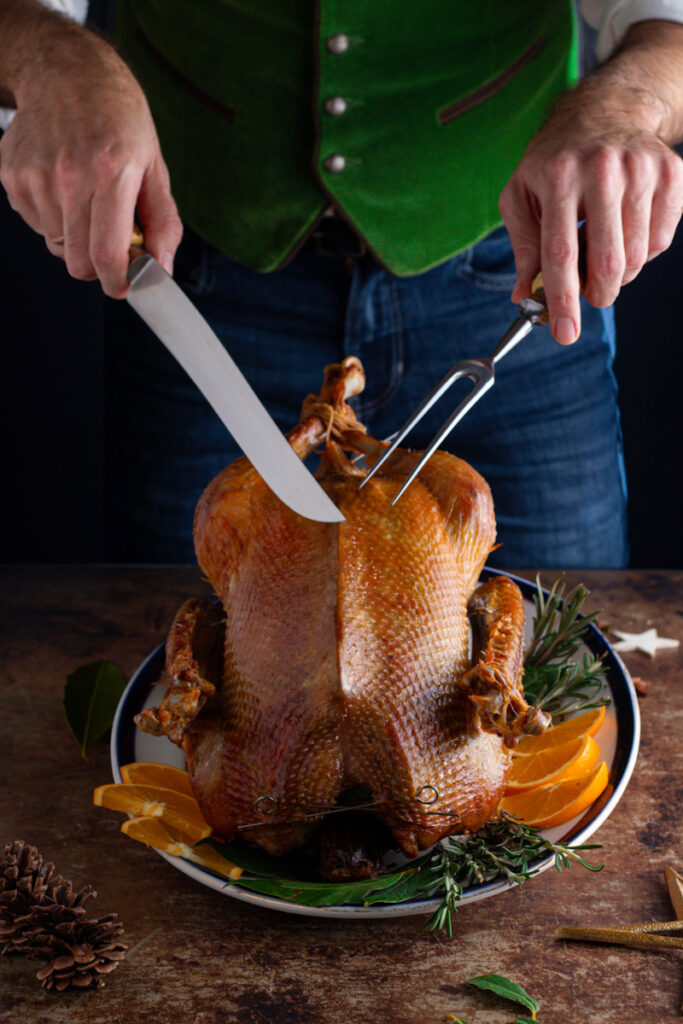
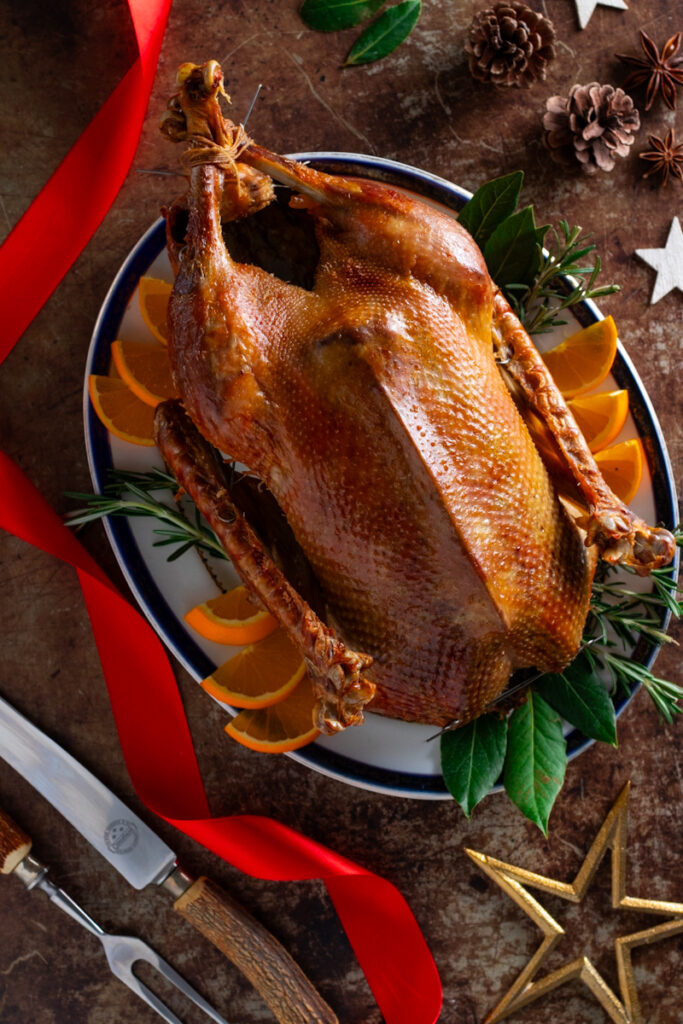
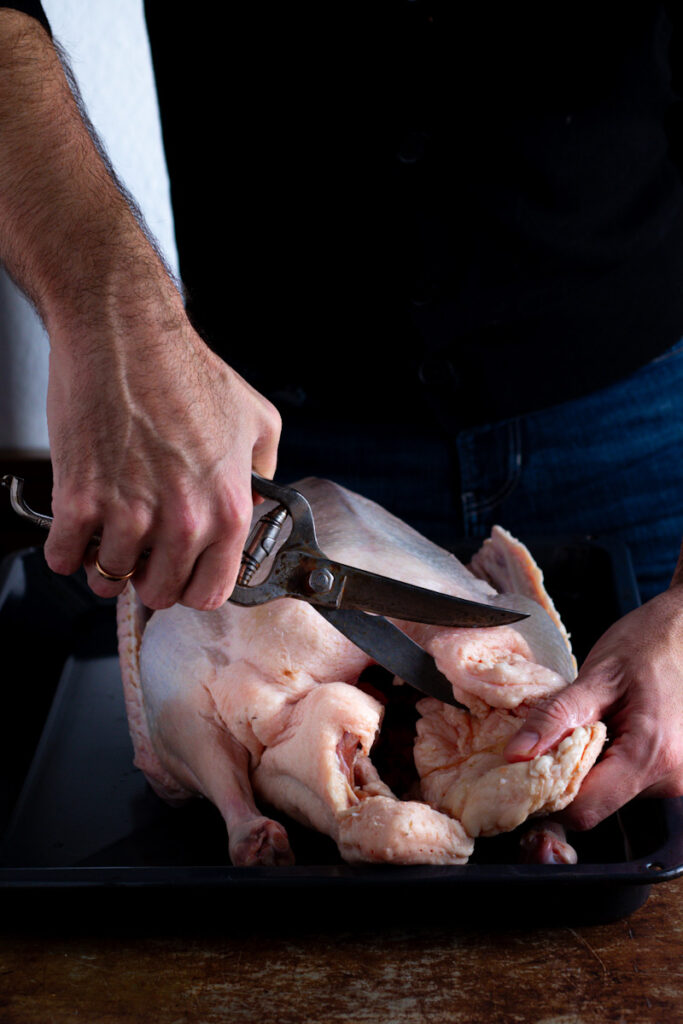
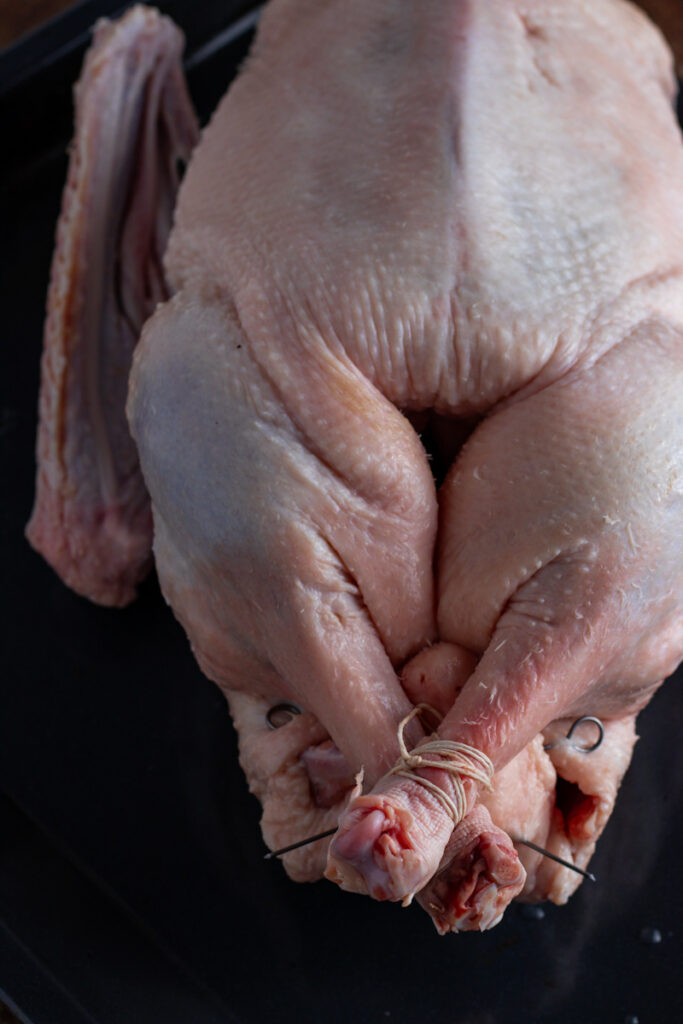
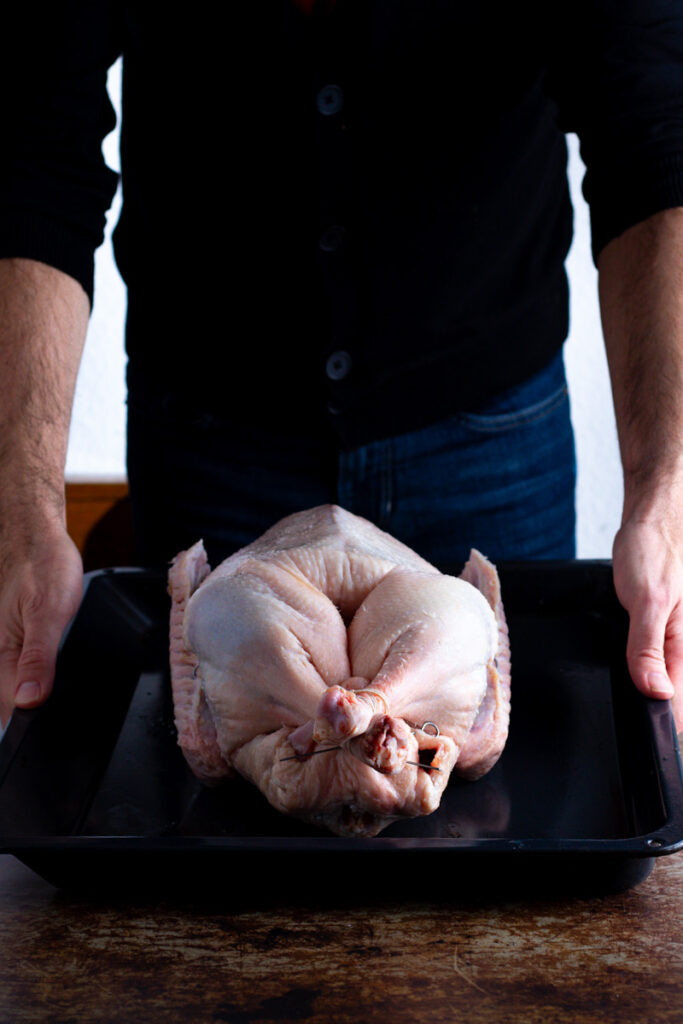
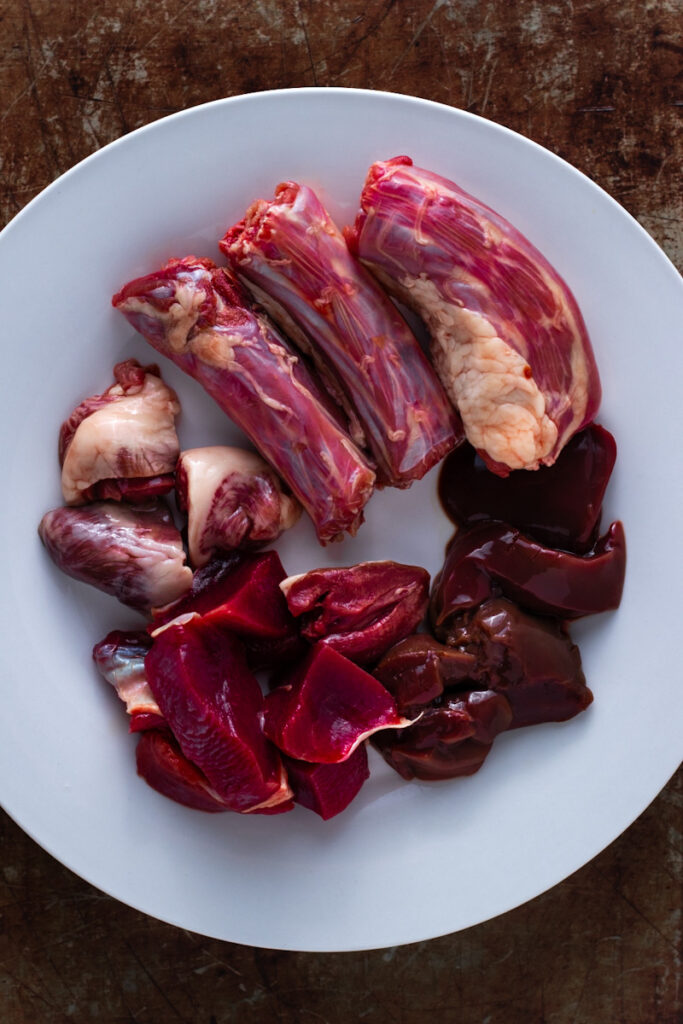
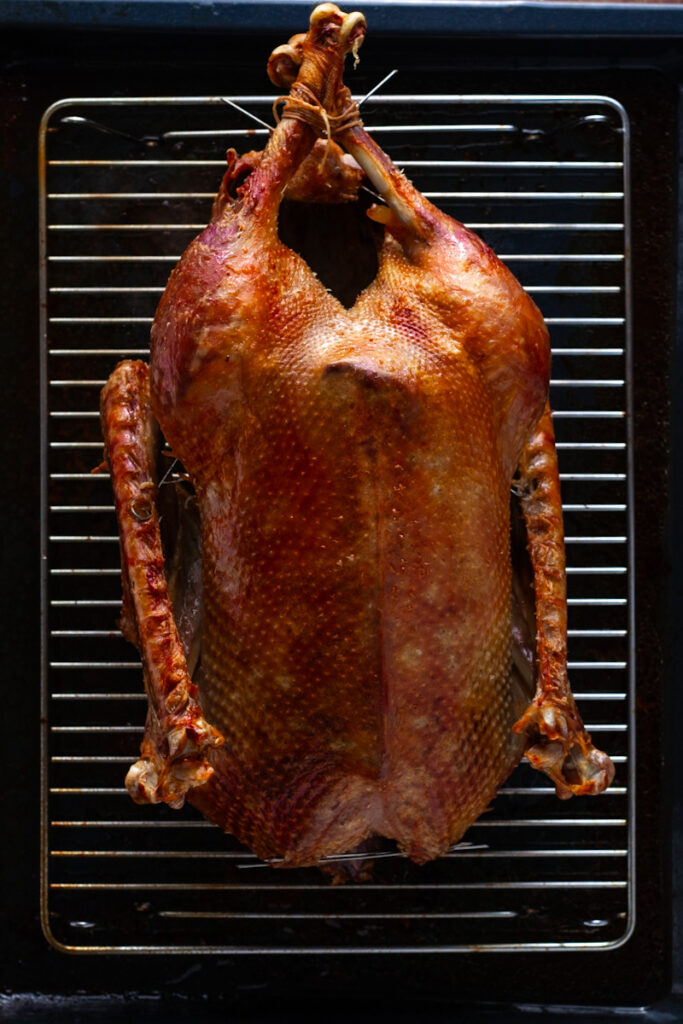
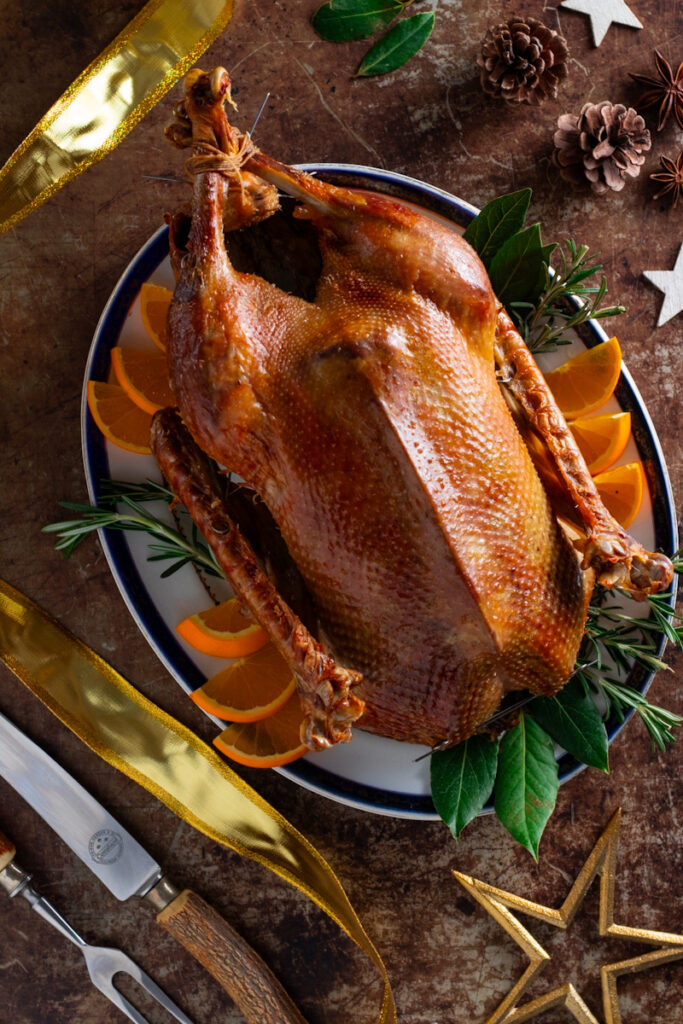
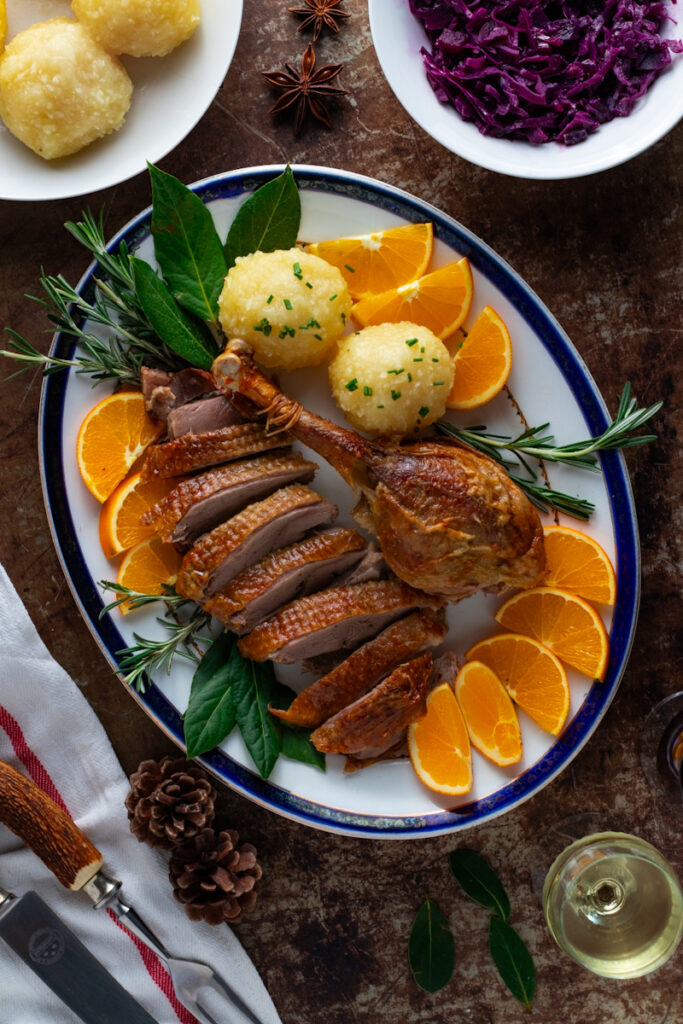
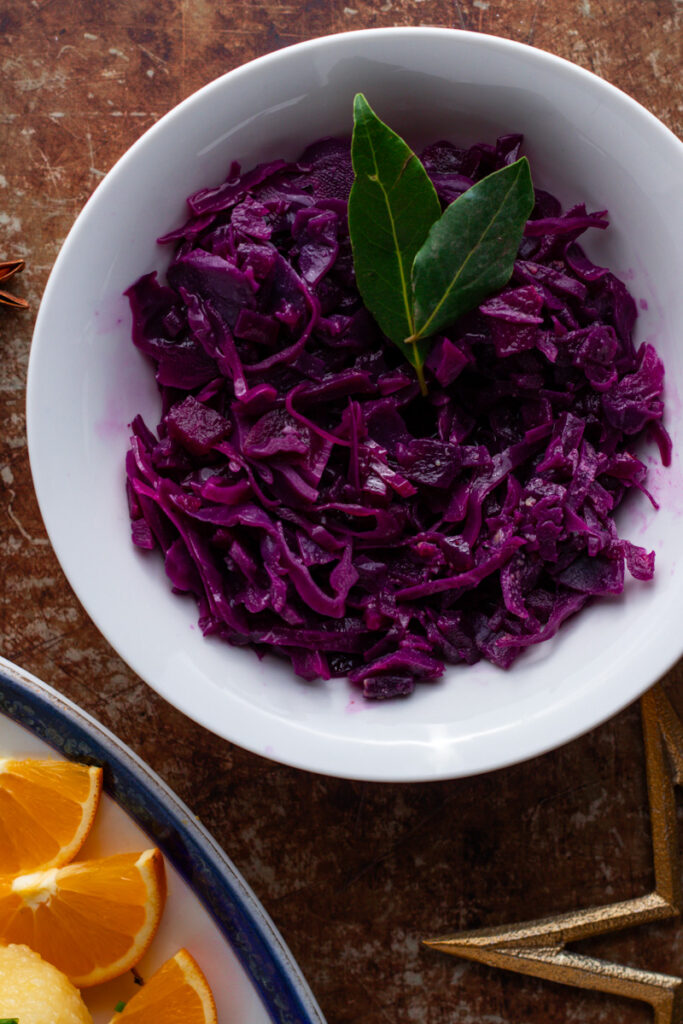
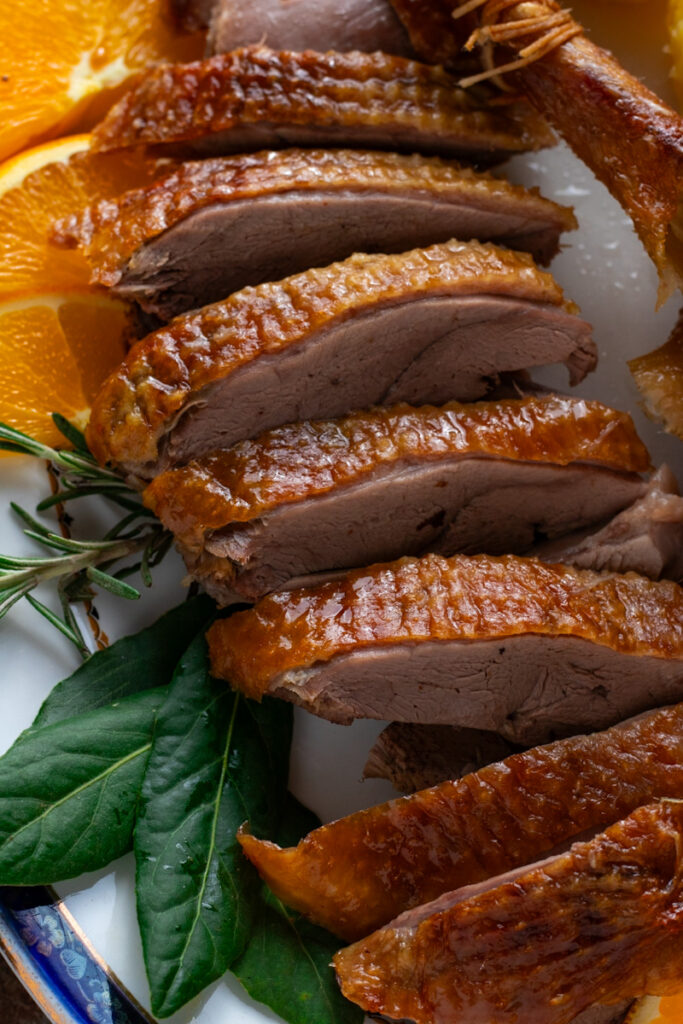
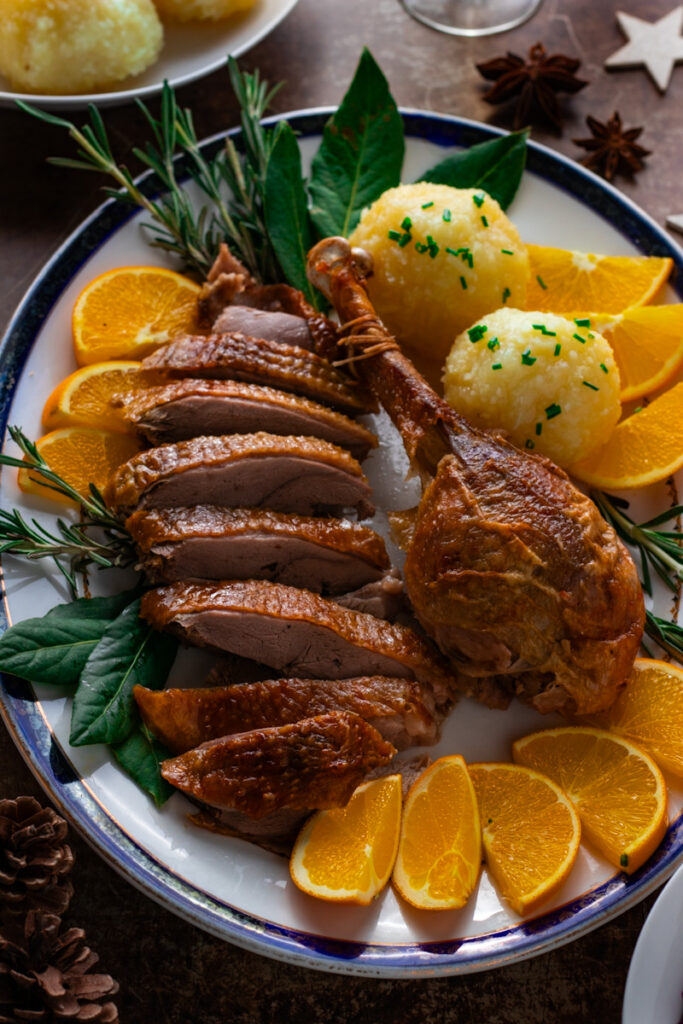
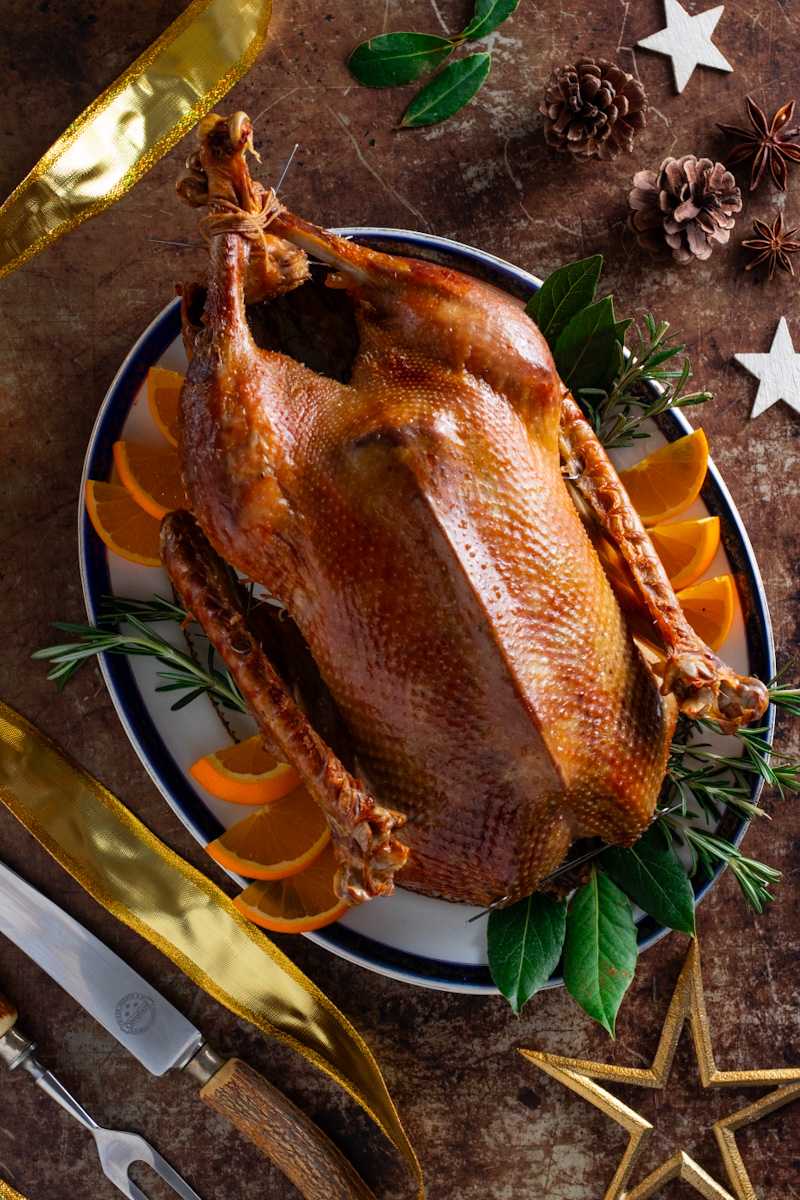



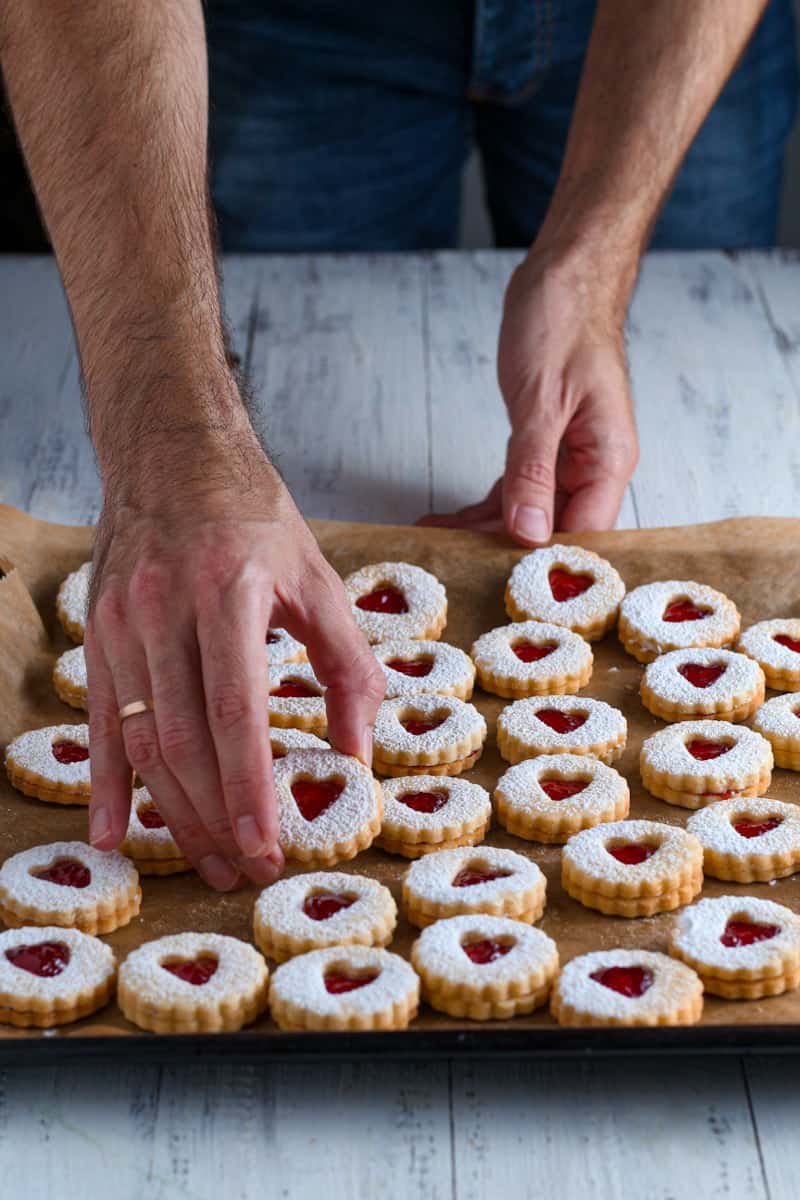
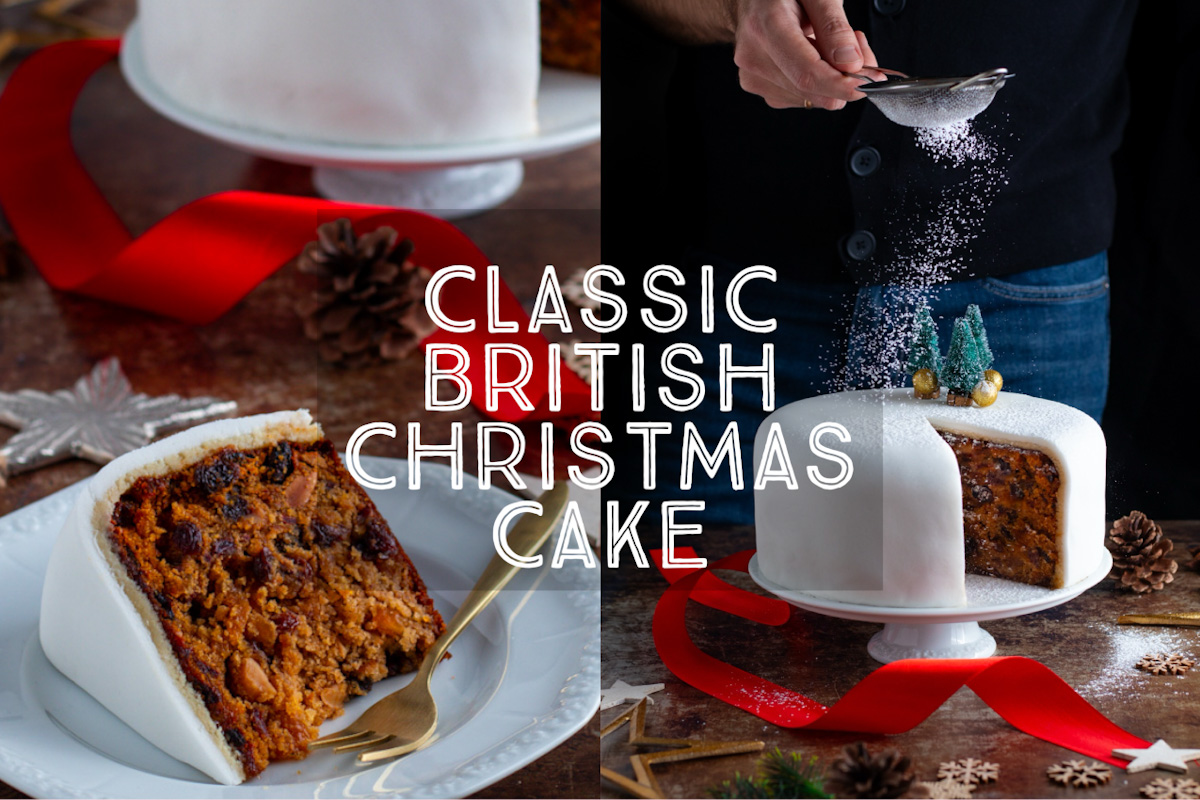
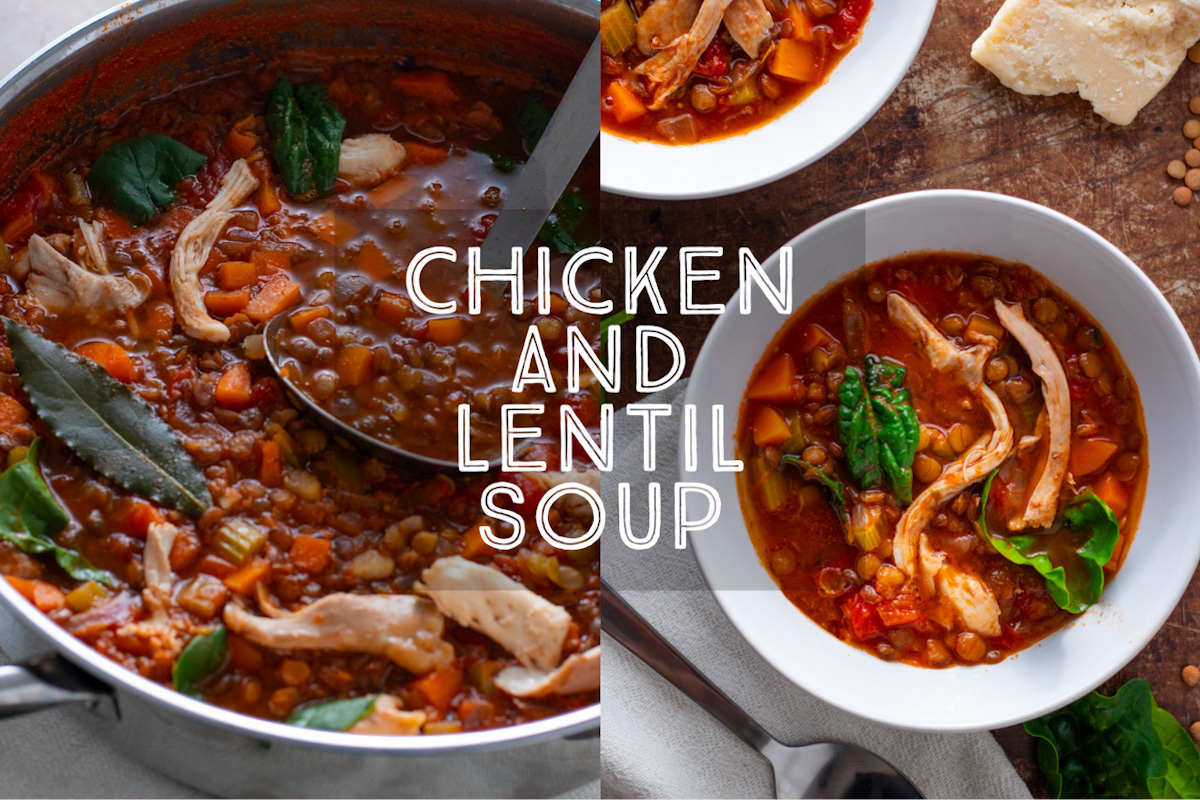
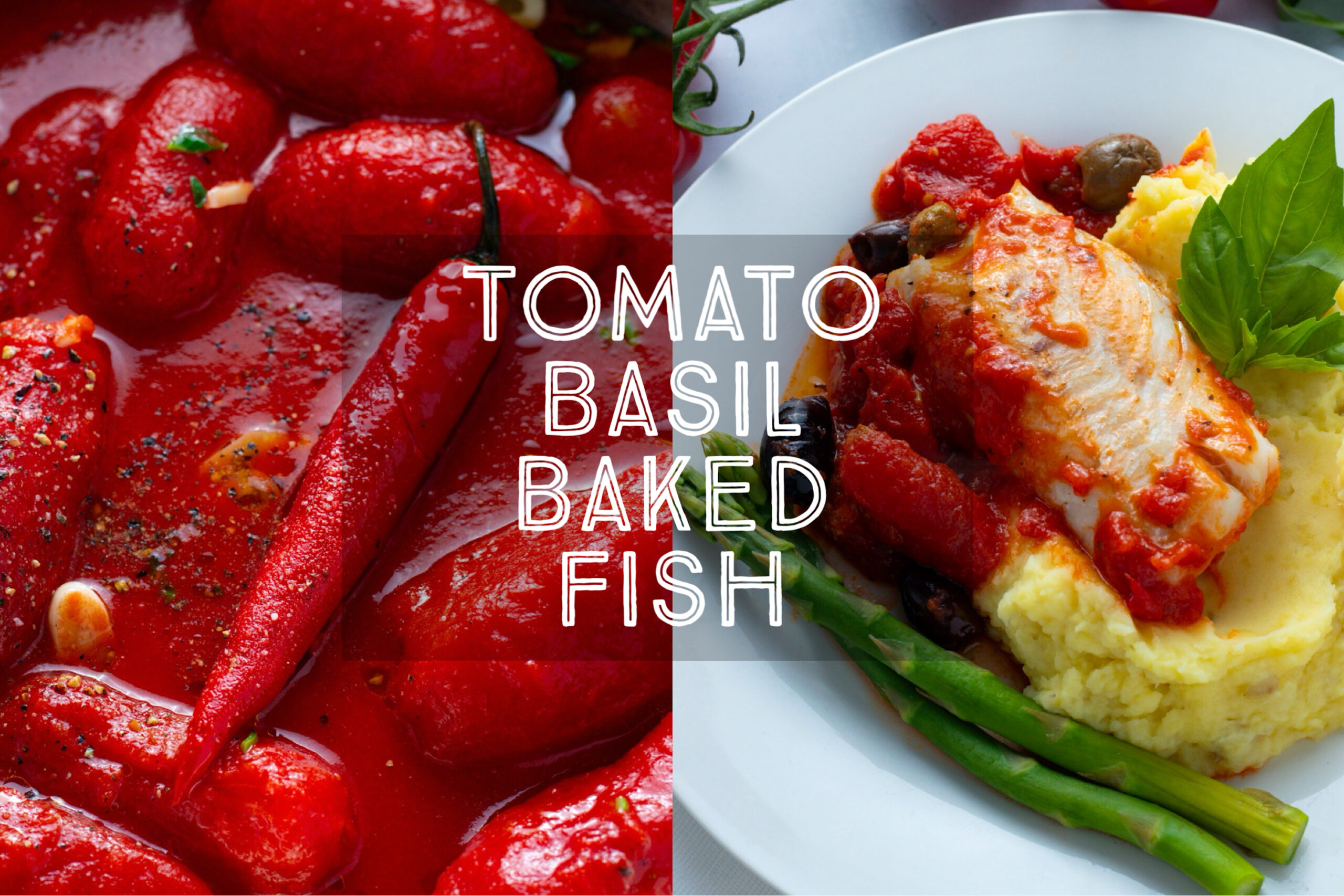
Hello,
Australian living in Germany,
I was wondering if there are any downfalls to making the gravy the night before and re heating it on the day. Is this possible?
Thank you for the recipe,
Sally
Hi Sally, sorry for the delayed reply! That is a great idea, and is much less stressful than trying to deal with the gravy and the bird all on the day. The gravy will be even better after a night in the fridge. 🙂 Let me know how you get on! Happy cooking, Jay
I was wondering how i would adjust the time if i use a smaller goose, around 4kg.
Hi Camille, great question! For a smaller goose simply calculate 30 minutes per kilogram (2.2 lb) at 180°C / 350°F / Gas 4. The legs should feel a little loose and wobbly if you give them a little shake and the skin should be golden bronze. You can also use a thermometer to check that the goose is 70°C/160°F when inserted into the thickest part of the thigh to be extra sure as some ovens run hot or cold.
You’ll need to let the goose rest in a warm spot, loosely covered with aluminium foil for 20 minutes after roasting.
Happy cooking and very best Christmas wishes! J.
Thank you! 🙂